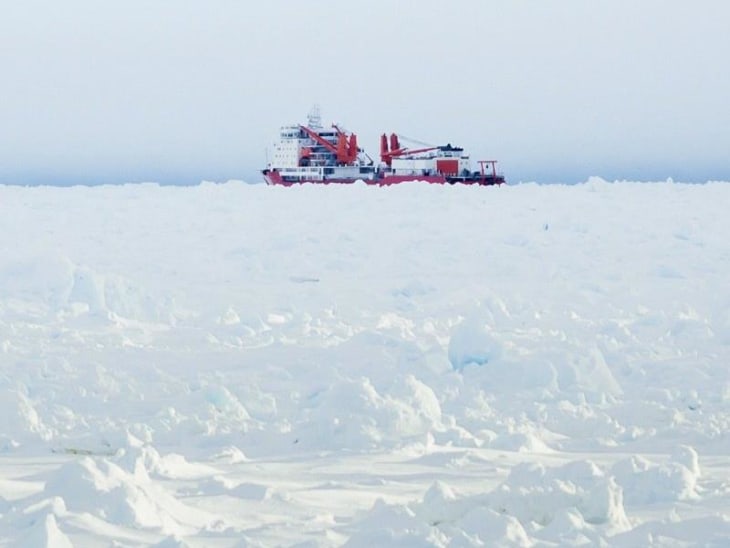How icebreakers work — and why they sometimes don't work

Andrew Peacock / Reuters
So near, and yet so far: The Chinese icebreaker Snow Dragon (Xue Long) sits in the Antarctic icepack, unable to get through to the Akademik Shokalskiy on Saturday. This picture was taken from the Shokalskiy.
Icebreakers are indispensable for traffic through polar seas, but they're not invincible — as the current plight of a stranded Russian ship illustrates.
For the past week, 74 scientists, tourists, journalists and crew members have been stuck aboard the Akademik Shokalskiy in the midst of an expedition to celebrate the centennial of Australian geologist Douglas Mawson's polar odyssey. So far, thick ice and bad weather have foiled efforts to free the ship. The Shokalskiy's passengers have ample supplies — but at some point, rescuers will have to decide whether to keep trying to break the ship loose or evacuate it using helicopters.
The Chinese icebreaker Snow Dragon (Xue Long) tried to approach the Shokalskiy over the weekend, but had to stay miles away because it couldn't crack through ice that ranges up to 10 feet (3 meters) thick. An Australian icebreaker, the Aurora Australis, is in the area but waiting for the weather to improve.
'Bathtub with a big engine'Traditional icebreakers like the Aurora Australis don't make their way through the thickest icepacks by cutting through it like a knife. Instead, their rounded keels slide over the ice and crash down into the water below. When they're in a tight spot, some ships can add to the oomph by shifting their water ballast back and forth to produce a rocking motion.
Greg Mortimer, co-leader of the Australasian Antarctic Expedition, told The Guardian that the basic design is "like a bathtub with a big engine inside it."
Even though the Snow Dragon is heavier than the Aurora Australis, Mortimer said he was hoping the "extra grunt" provided by the Australian ship could make the difference.
On Monday, the Australian ship had to back off to a position 20 miles from the Shokalskiy, due to poor visibility and 35 mph winds, but it will try once again to head for the Russian ship when conditions improve.
The Aurora Australis is designed to break through level ice that's up to 4 feet (1.23 meters) deep, at a speed of 3 mph. The ship might not be able to get through a 10-foot-thick layer of solid ice, but passengers on the Shokalskiy have been reporting that the ice around the ship is breaking up. That's raising hopes that the tide might be turning in their favor.
If the Australian ship can't get through, the likeliest scenario is that helicopters will have to airlift the Shokalskiy's passengers from the ship — and leave behind what they can't carry.
America's icebreakersThe Australian Maritime Safety Authority's Rescue Coordination Center is in charge of the rescue effort, but the fact that a Chinese ship is playing such a key role points to the international cooperation that's often required for Antarctic operations. The U.S. Coast Guard currently has two Seattle-based icebreakers in service: the medium-class Healy, which recently wrapped up an Arctic expedition; and the heavyweight Polar Star, which is en route to Antarctica to clear a channel to the U.S. base in McMurdo Sound.
The Polar Star is just returning to service after a years-long, $56 million overhaul. It's designed to get through a 6-foot-thick (2-meter-thick) layer of ice in the forward direction — and when it's in its backing-up-and-ramming mode, it's capable of handling ice that's up to 21 feet (6.5 meters) thick.
The expedition leader on the Shokalskiy, Chris Turney, told TODAY that the Polar Star could "definitely get us out" — but for now, at least, that's not likely to happen.
"As of right now Australia is coordinating the rescue operations," Coast Guard spokeswoman Allyson Conroy said in a statement. "The nearest U.S. Coast Guard asset is more than 3,000 nautical miles away. We are communicating with Australia and standing by if our assistance is indeed needed."
No comments:
Post a Comment